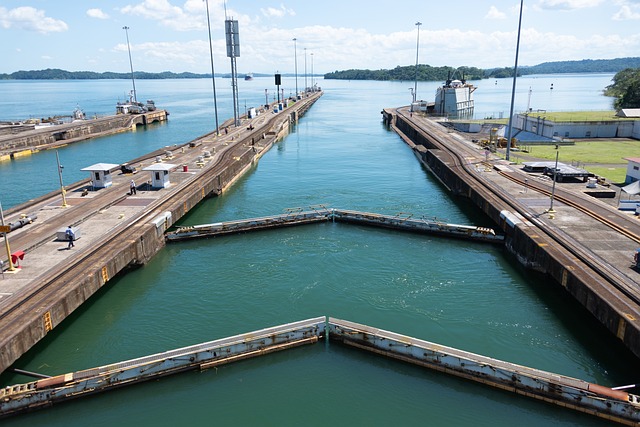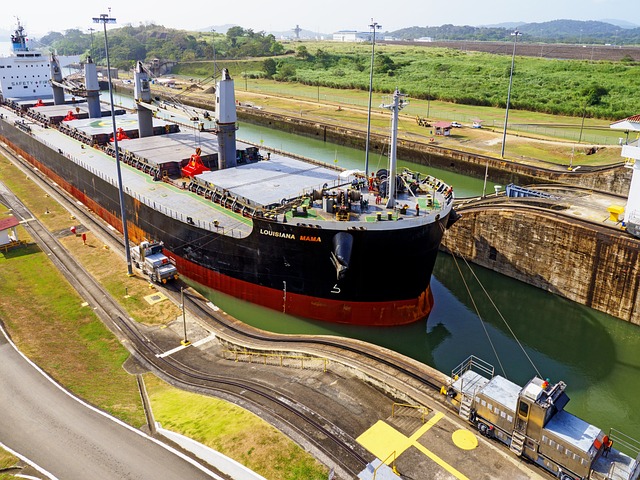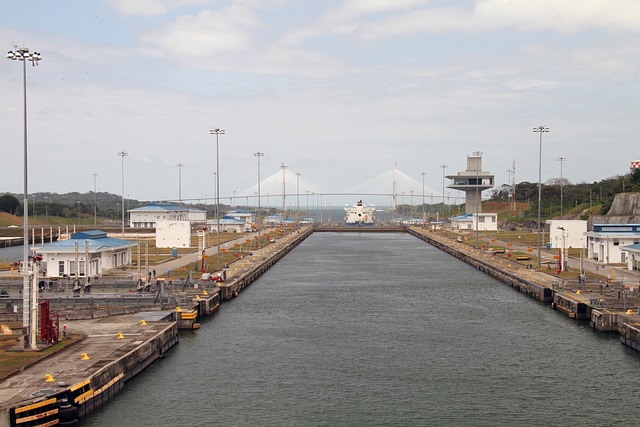The Panama Canal is a remarkable feat of engineering that has played a pivotal role in shaping global trade and connecting continents. It has been a vital trade route for over a century, cutting through the isthmus of Panama to link the Atlantic and Pacific oceans.
In this article, we will explore the historical significance of the Panama Canal and its impact on global trade. From its construction to modernization efforts and future plans, we will delve into the crucial role it plays in international relations and the global economy.
So let’s take a closer look at how the Panama Canal continues to shape global trade and commerce.
Table of Contents
Connecting Continents: The Construction of the Panama Canal
The Panama Canal is undoubtedly one of the most significant engineering marvels of the modern world. It connects two major continents, North and South America, and has played a crucial role in shaping global trade and commerce. The canal has a rich history dating back to the early 16th century when Spanish conquistadors first explored the narrow strip of land connecting the two continents. It wasn’t until the late 19th century that the dream of creating a waterway through the Isthmus of Panama became a reality.

The construction of the Panama Canal was a monumental undertaking, with a complex network of locks, dams, and a 51-mile-long waterway. However, this ambitious project faced numerous challenges, both technical and political. One of the most significant hurdles was the difficult terrain of the Isthmus, with steep mountains and dense forests, making it a daunting task for engineers and workers.
Despite the challenges, the construction of the Panama Canal was made possible by innovative engineering techniques and advancements in technology. French engineer Ferdinand de Lesseps initially led the project but faced financial and technical difficulties, forcing him to abandon the project. The United States took over the construction in 1904 and used groundbreaking techniques such as massive dredging and excavation, concrete pouring, and the introduction of the railroad to transport equipment and materials.
The Panama Canal’s construction was an engineering feat, with the builders having to overcome challenges such as excavating through the Culebra Cut, a mountainous region known for its unstable rock formations and landslides. The construction also faced challenges from tropical diseases such as malaria and yellow fever, which claimed the lives of many workers, including French engineer de Lesseps.
Despite the challenges, the Panama Canal officially opened in 1914, connecting the Atlantic and Pacific Oceans and providing a vital shortcut for global trade. The canal’s impact was immediate, with a significant increase in trade and shipping between the two coasts of the United States and a significant reduction in transportation costs for goods.
Today, the Panama Canal handles over 5% of the world’s total trade volume, with over 14,000 ships passing through annually. It has played a crucial role in connecting continents and facilitating global trade, becoming an essential link in the supply chains of various industries such as agriculture, manufacturing, and energy.
The economic impact of the Panama Canal cannot be overstated. It has not only boosted the economies of the countries involved but has also influenced global trade patterns. The canal has provided a vital link between the Americas and Asia, allowing for faster and more efficient trade routes between the two regions.
However, the construction of the Panama Canal also had significant environmental consequences. The creation of the waterway led to the flooding of vast areas of land, displacing local communities and causing ecological disruptions. In recent years, there have been efforts to sustain and preserve the canal’s ecosystem, with the implementation of environmental projects such as reforestation and water management initiatives.
In conclusion, the construction of the Panama Canal was a monumental feat that connected continents and revolutionized global trade. It has withstood the test of time and continues to play a crucial role in shaping the world’s economy. The next section will explore the impact of the Panama Canal on global trade and its relevance in the 21st century.
Shaping Global Trade: The Panama Canal’s Impact
The Panama Canal has not only connected continents, but it has also shaped global trade in a significant way. From its construction to its modernization and expansion, the canal has revolutionized the shipping industry and reduced transportation costs for goods. In this section, we will explore the impact of the Panama Canal on global trade and commerce, highlighting its contributions to specific industries and countries, and discussing its environmental impact and sustainability efforts.
First and foremost, the Panama Canal has played a crucial role in facilitating international trade and commerce since its completion in 1914. Before the canal’s construction, ships had to navigate around the southern tip of South America, which was a long and treacherous journey. With the canal, ships can now pass through the narrow isthmus of Panama, connecting the Atlantic and Pacific oceans, and saving time and money for global trade.
In terms of economic impact, the Panama Canal has been a game-changer for the countries involved. According to the Panama Canal Authority, the canal handles around 6% of the world’s total trade, with an estimated 14,000 ships passing through each year. This makes it a vital route for the transportation of goods, resulting in significant economic benefits for the countries that use it. For example, the canal has been a major contributor to Panama’s economy, generating approximately 40% of the country’s gross domestic product (GDP).
The Panama Canal has also had a profound effect on specific industries, such as shipping and agriculture. With the canal’s creation, shipping routes were shortened, and transportation costs were reduced, making it easier and more cost-effective for companies to transport goods. This has led to increased trade and economic growth, particularly in industries that rely heavily on imports and exports. Additionally, the canal has supported the growth of Panama’s agricultural sector, allowing for the efficient export of goods such as bananas, coffee, and sugar.
While the Panama Canal has brought numerous benefits to global trade, it has also faced criticism for its environmental impact. The construction of the canal involved the excavation of over 170 million cubic meters of earth, resulting in the displacement of indigenous communities and the destruction of natural habitats. However, in recent years, the Panama Canal Authority has implemented measures to mitigate these effects, such as reforestation projects and the use of advanced technology to reduce water usage.
In terms of sustainability, the Panama Canal has been recognized as an engineering marvel, with its innovative locks and water-saving systems. These efforts have not only reduced the canal’s environmental impact but have also increased its capacity to accommodate larger ships and increased trade demand. Furthermore, the canal’s expansion project, completed in 2016, has further modernized the infrastructure and increased its capacity to handle even more trade.
The Panama Canal’s impact on global trade extends beyond just the physical movement of goods. It has also played a significant role in shaping global events and crises. During the COVID-19 pandemic, the canal remained open, allowing for the uninterrupted flow of essential goods and supplies. This has highlighted the canal’s crucial role in maintaining global trade and supporting international cooperation.
In conclusion, the Panama Canal’s impact on global trade cannot be overstated. It has connected continents, reduced transportation costs, and facilitated economic growth for countries worldwide. While facing challenges and criticism, the canal has continuously adapted and modernized to meet the changing demands of global trade. Its role in international relations and diplomacy is also significant, making it an essential player in the global trade landscape of the 21st century.

The Panama Canal Today: Modernization and Expansion
The Panama Canal, which connects the Atlantic and Pacific oceans, has been a vital trade route for over a century. However, as global trade and shipping continue to evolve, the need for modernization and expansion of the canal has become apparent. In this section, we will explore the efforts and advancements made to modernize and expand the Panama Canal to meet the demands of today’s global trade landscape.
Since its opening in 1914, the Panama Canal has undergone several modernization efforts to improve its operations. In 2016, a major expansion project was completed, adding a third set of locks to the canal. This has allowed for the passage of larger ships, increasing the canal’s capacity and reducing transit times. The new locks are equipped with state-of-the-art technology, including water-saving basins and rolling gates, making the canal more efficient and environmentally friendly.
One of the main reasons for the expansion of the Panama Canal was the growing demand for larger ships, especially in the shipping industry. With the expansion, the canal now allows for the passage of Neopanamax vessels, which are capable of carrying up to 14,000 containers. This has significantly increased the canal’s capacity, and as a result, the volume of trade passing through the canal has also increased. In fact, since the expansion, the Panama Canal has seen a 21% increase in annual transits, with over 13,000 vessels passing through in 2020 alone.
The expanded Panama Canal has also brought economic benefits for the countries involved. With faster transit times and the ability to accommodate larger ships, trade between the Atlantic and Pacific regions has become more efficient and cost-effective. This has resulted in increased trade and economic growth for countries such as the United States, China, and Chile, among others. The Panama Canal also generates revenue for Panama, with tolls accounting for a significant portion of the country’s GDP.
However, the expansion project has not been without controversies. The estimated cost of $5.2 billion was surpassed, and the project faced delays and disputes over contract terms. There were also concerns raised about the environmental impact of the expansion, as it involved dredging and widening of the canal, which could potentially harm the delicate ecosystems surrounding it. To address these concerns, the Panama Canal Authority has implemented various environmental initiatives, such as reforestation and water conservation projects.
Looking ahead, the Panama Canal continues to focus on modernization efforts to remain competitive in the global trade market. The canal has introduced digital technologies, such as a mobile application for vessel scheduling, to improve efficiency and communication. Plans for a fourth set of locks and a new bridge are also in the works, which would further improve the canal’s capacity and connectivity.
In conclusion, the modernization and expansion of the Panama Canal have been crucial in keeping this vital trade route relevant and competitive in the 21st century. With technological advancements and increased capacity, the canal continues to play a significant role in global trade and economic growth. And with future plans for development, the Panama Canal will remain an integral part of international trade and relations for years to come.

The Importance of the Panama Canal in the 21st Century
The Panama Canal, often referred to as the “Eighth Wonder of the World”, has been a vital trade route connecting continents and shaping global trade for over a century. As we enter the 21st century, the Panama Canal continues to play a crucial role in the global trade landscape, adapting to changing trade patterns and technologies to remain a key player in international commerce.
Adapting to Changing Trade Patterns and Technologies:
In recent years, the Panama Canal has undergone significant modernization efforts and expansion projects to accommodate larger ships and increased trade volume. This has been necessary to keep up with the evolving demands of global trade and to remain competitive in an ever-changing market. The introduction of new technologies such as Automated Guided Vessels (AGVs) and the use of geospatial data has improved efficiency and reduced transit times, making the Panama Canal an attractive option for shipping companies.
Global Events and Crises:
The COVID-19 pandemic has highlighted the importance of the Panama Canal in maintaining the flow of essential goods and supplies across the globe. Despite facing challenges such as reduced workforce and stricter safety measures, the Panama Canal has continued to operate and play a crucial role in supporting global trade during this crisis. The canal’s adaptability and resilience have been crucial in keeping supply chains moving and allowing countries to access vital resources.
Future Plans and Potential Developments:
The Panama Canal Authority (ACP) has plans to further expand and modernize the canal to accommodate even larger ships and increase its capacity. The $5.25 billion expansion project, completed in 2016, has already increased the canal’s capacity by 20%. These developments are essential in keeping up with the growing demands of global trade and ensuring the canal remains a cost-effective and efficient route for shipping goods.
Promoting Global Cooperation and Trade Partnerships:
The Panama Canal has played a role not only in facilitating trade but also in promoting global cooperation and trade partnerships. The canal has been a symbol of international cooperation and diplomacy, with over 144 different flags passing through its waters daily. It has also played a significant role in fostering relationships between Panama and other countries, promoting economic growth and development in the region.
Conclusion:
In conclusion, the Panama Canal continues to be a vital artery in the global trade network, connecting continents and shaping global commerce. Its adaptability, modernization efforts, and potential for future expansion make it a crucial player in the 21st-century economy. The canal’s ability to withstand challenges and promote cooperation makes it a symbol of progress and development in the international community. As we move forward, the Panama Canal will undoubtedly continue to play a crucial role in shaping global trade and relations.
The Panama Canal and International Relations
The Panama Canal has not only been a crucial trade route and economic lifeline, but it has also played a significant role in shaping international relations and diplomacy. Since its construction in 1914, the Panama Canal has been a focal point for global trade and has had a profound impact on the relationships between countries.
One of the most significant ways in which the Panama Canal has affected international relations is through its impact on global trade. The canal has provided a vital link between the Atlantic and Pacific oceans, allowing for the seamless transportation of goods between continents. This has not only boosted trade between countries but has also fostered economic cooperation and partnerships.
The canal has also played a critical role in the relationships between Panama and other countries. As the owner and operator of the Panama Canal, the Panamanian government has used its control of this vital route to strengthen its ties with other nations. For instance, Panama has signed numerous trade agreements and partnerships with countries like the United States, China, and European nations, leveraging the canal as a key bargaining tool.
Furthermore, the Panama Canal has been used as a political and economic tool for countries to exert their influence and power on a global scale. For example, during the Cold War, the United States used its control of the Panama Canal as a strategic military base, further solidifying its dominance in the region. The canal’s importance has also been evident in international crises, such as the recent COVID-19 pandemic, where the canal played a crucial role in maintaining the flow of essential goods and supplies between countries.
In addition to its impact on global trade and politics, the Panama Canal has also been a symbol of cooperation and partnership between nations. The construction and modernization of the canal have involved the collaboration of multiple countries, highlighting the potential for international cooperation and peaceful relations.
The future potential of the Panama Canal in promoting global cooperation and trade partnerships is immense. With the expanded canal’s increased capacity and efficiency, it has the potential to facilitate even more significant volumes of trade between countries. This can lead to stronger economic ties and partnerships, ultimately fostering better diplomatic relations.
In conclusion, the Panama Canal has been a vital player in international relations and diplomacy. Its impact on global trade, the relationships between countries, and its symbolic value as a symbol of cooperation cannot be overlooked. As the world continues to evolve, the Panama Canal will undoubtedly play a crucial role in shaping international relations and promoting global cooperation.
